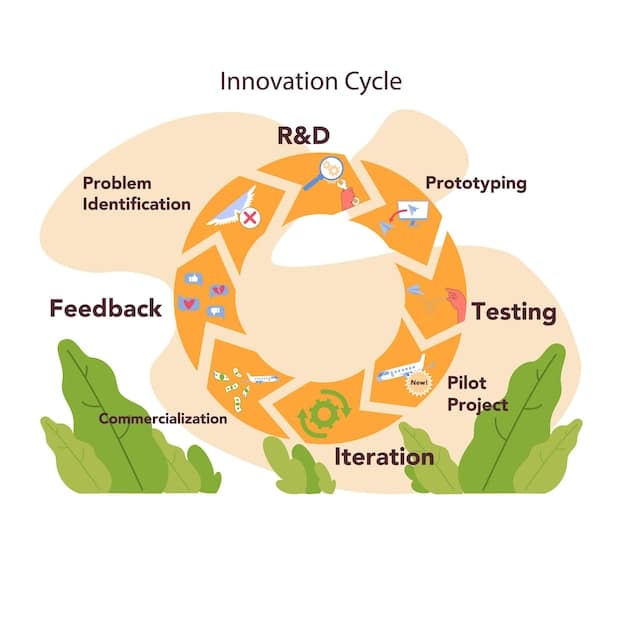US EdTech Grants: Secure Funding for Your School Now

Securing funding for educational technology initiatives in U.S. schools and districts within the next six months requires a strategic approach, focusing on understanding grant opportunities, precise proposal writing, and demonstrating clear alignment with educational goals and student outcomes.
Navigating the landscape of education funding can be a complex endeavor, yet securing a US Education Technology Grant could be the pivotal step in transforming learning environments for your students. This guide provides a strategic roadmap for schools and districts aiming to secure vital funding within the next six months, offering insights into effective grant acquisition, common pitfalls to avoid, and best practices for demonstrating impact.
Understanding the EdTech Funding Landscape
The U.S. education technology funding landscape is dynamic, shaped by federal, state, and private initiatives designed to enhance learning outcomes through innovation. Grasping the nuances of these various funding streams is the critical first step for any school or district seeking to bolster its EdTech infrastructure. Federal programs often target broad national priorities, such as closing achievement gaps or promoting STEM education, while state-level grants might address specific regional needs or educational mandates. Private foundations, on the other hand, frequently look for innovative, replicable models that align with their philanthropic missions.
Federal Funding Sources for EdTech
Federal grants are a significant source of funding, often distributed through competitive programs or formula grants to states. These funds frequently come with stringent reporting requirements and specific use cases, emphasizing accountability and measurable outcomes. Understanding the legislative acts that authorize these grants, such as the Elementary and Secondary Education Act (ESEA) as amended by the Every Student Succeeds Act (ESSA), is crucial. These acts outline pathways for technology integration, professional development, and equitable access.
- The Every Student Succeeds Act (ESSA) Title IV, Part A: Student Support and Academic Enrichment (SSAE) grants often support well-rounded education, including technology.
- Individuals with Disabilities Education Act (IDEA): Funds can be used for assistive technology and related services for students with disabilities.
- Competitive grants from agencies like the Department of Education, such as those focusing on rural education or specific innovation challenges.
State and Local Opportunities
Beyond federal aid, states often allocate their own funds for educational technology. These can include direct grants to districts, incentive programs for technology adoption, or funding for statewide initiatives like broadband expansion. Local education agencies (LEAs) should actively monitor their state Department of Education websites and attend regional conferences for announcements. Additionally, many philanthropic organizations and community foundations offer grants specifically tailored to local educational needs, often prioritizing projects that demonstrate direct community impact.
Staying informed about upcoming cycles for these varied grants is paramount. This involves subscribing to relevant newsletters, regularly checking government and foundation websites, and networking with other educators and grant professionals. Early intelligence allows for proactive planning, which is indispensable for successful grant applications. This comprehensive understanding ensures that schools and districts can identify the opportunities best suited to their unique needs and strategic goals, setting a strong foundation for future success in securing essential EdTech funding.
Strategic Planning and Needs Assessment
Before embarking on the grant writing process, a meticulous strategic plan and a thorough needs assessment are indispensable. This foundational work ensures that any proposed technology initiative is not only deserving of funding but also genuinely impactful for students and educators. A well-defined strategy demonstrates foresight and fiscal responsibility, qualities highly valued by grant providers. It also aligns the proposed EdTech solutions directly with the specific pain points and educational goals of your school or district.
Conducting a Comprehensive Needs Assessment
A needs assessment involves systematically identifying the gaps between current educational practices and desired learning outcomes, specifically in relation to technology integration. This process goes beyond simply wanting new devices; it delves into how technology can solve specific problems, improve instruction, or enhance student engagement. It requires gathering data from various stakeholders, including teachers, administrators, IT staff, students, and parents. Surveys, focus groups, and existing performance data (e.g., test scores, attendance rates) can provide rich insights.
- Identify current technology infrastructure strengths and weaknesses.
- Assess teacher professional development needs related to EdTech.
- Analyze student engagement and achievement data to pinpoint areas where technology could make a difference.
- Gather feedback from all stakeholders on desired technology capabilities and perceived challenges.
Aligning Goals with Grant Opportunities
Once needs are identified, the next critical step is to connect these needs with the objectives of potential grant opportunities. Each grant program has specific priorities and eligibility criteria. A successful grant application is one that clearly articulates how the proposed project directly addresses these priorities while solving a demonstrated need within the applicant’s context. This alignment demonstrates not just a desire for funding, but a thoughtful strategy for how that funding will be leveraged for maximum impact.
For example, if a grant program emphasizes enhancing digital literacy for underserved students, your proposal should detail how your identified need for updated computing labs directly addresses this by providing equitable access and tailored curricula. This direct correlation makes your application stand out. Additionally, consider how your project can scale or serve as a model for other schools, as funders often look for broader impact. Strategic planning, coupled with a rigorous needs assessment, transforms a wish list into a compelling, data-driven proposal that speaks directly to the grantors’ goals.
Crafting a Compelling Grant Proposal
A compelling grant proposal is the cornerstone of successful funding acquisition. It’s more than just a request for money; it’s a persuasive narrative that articulates a clear vision, demonstrates genuine need, and outlines a meticulously planned approach to achieving measurable outcomes. Crafting such a document requires clarity, precision, and adherence to the grantor’s specific guidelines, ensuring every element reinforces the project’s value and viability.
Key Components of a Strong Proposal
Every grant proposal, regardless of the funding source, typically comprises several essential sections. The executive summary, often written last but placed first, provides a concise overview of the entire project, hooking the reader. The statement of need uses data and anecdotal evidence to powerfully illustrate why the project is necessary. The project description then details what will be done, by whom, and over what timeframe, emphasizing the proposed EdTech solutions. Clear, concise language is crucial here, avoiding jargon and focusing on the practical application of technology.

The objectives must be SMART: Specific, Measurable, Achievable, Relevant, and Time-bound. This allows both the applicant and the grantor to track progress and evaluate success. The evaluation plan section outlines how the project’s impact will be measured, often using both quantitative and qualitative data. A detailed budget, justifying every expense, and a sustainability plan, explaining how the project will continue after initial funding, are also vital for demonstrating responsibility and long-term vision.
Tips for Effective Grant Writing
Effective grant writing demands more than just good ideas; it requires a strategic approach to communication. Start early, allowing ample time for research, collaboration, and multiple rounds of revisions. Adhere strictly to word counts, formatting requirements, and submission deadlines. Tailor each proposal to the specific grantor, incorporating their language, priorities, and values where appropriate. Resist the temptation to submit a generic proposal to multiple funders; personalization significantly increases success rates.
Focus on impact: clearly articulate the direct benefits for students, teachers, and the broader school community. Use strong, active voice and avoid vague language. Proofread meticulously to eliminate errors that could undermine credibility. Consider sharing a draft with colleagues or a critical friend for feedback, as fresh eyes can catch omissions or ambiguities. A well-written grant proposal not only secures funding but also serves as a foundational document for project implementation, guiding the team and ensuring alignment with initial goals.
Budgeting and Financial Planning
Effective budgeting and meticulous financial planning are paramount in grant applications, as they demonstrate fiscal responsibility and a clear understanding of the project’s financial needs. A well-constructed budget not only justifies every expense but also assures the grantor that funds will be utilized efficiently and effectively toward achieving the proposed educational technology goals. It’s a transparent breakdown of where every dollar will go, reflecting a deep commitment to maximizing the impact of the investment.
Developing a Detailed and Justified Budget
A grant budget should be comprehensive, detailing all anticipated costs associated with the EdTech project. This includes direct costs such as technology hardware (laptops, interactive whiteboards), software licenses, professional development for staff, and implementation support. Indirect costs, like administrative overhead or facility usage, should also be factored in according to grantor guidelines. Each line item must be clearly justified, explaining its necessity for the project’s success. For instance, explaining why a specific number of devices is needed per student or detailing the cost of a particular professional development workshop.
- Hardware acquisition: computers, tablets, projectors, networking equipment.
- Software licenses: educational platforms, learning management systems, creative tools.
- Professional development: training for teachers on new technology, ongoing support.
- Maintenance and support: technical assistance, warranties, upgrades.
- Sustainability costs: future funding sources for ongoing operations and replacements.
Securing Matching Funds or In-Kind Contributions
Some grant programs require or prioritize applicants who can demonstrate matching funds or in-kind contributions. Matching funds are direct financial contributions from the school, district, or other partners, indicating shared investment. In-kind contributions represent the value of non-monetary resources provided, such as staff time dedicated to the project, volunteer hours, donated equipment, or facility usage. Highlighting these contributions strengthens the application, showing a commitment beyond the grant itself.
For example, a school might allocate existing budget funds for teacher stipends related to technology training or dedicate a portion of an IT specialist’s salary to managing the new devices as an in-kind contribution. Quantifying these contributions in your budget speaks volumes about your institution’s dedication and belief in the project’s success. Moreover, demonstrating a clear sustainability plan, outlining how the technology will be maintained, updated, and funded beyond the initial grant period, is often a requirement and always a strong selling point, reassuring funders that their investment will have lasting impact.
Demonstrating Impact and Sustainability
For any educational technology initiative, demonstrating clear impact and a viable path to sustainability are critical components that distinguish successful grant applications from the rest. Funders are not merely interested in initial implementation; they want to see tangible evidence that their investment will lead to positive, measurable outcomes for students and teachers, and that the project will continue to thrive long after the initial funding period concludes. This requires a forward-thinking approach that integrates evaluation and long-term planning from the outset.
Measuring Project Outcomes and Evaluation
A robust evaluation plan is essential for demonstrating impact. This plan should clearly define what success looks like and how it will be measured. It involves identifying specific, measurable metrics that align with the project’s objectives. These metrics can vary widely, including improvements in student test scores, increased student engagement, enhanced teacher efficacy in using technology, or even improvements in attendance rates directly linked to the EdTech intervention. Baseline data is crucial here to show progress over time.
For example, if the goal is to improve digital literacy, metrics might include pre- and post-assessments of student digital skills, surveys on teacher comfort with new tools, or tracking the frequency of technology use in classrooms. Regularly collecting and analyzing this data allows for ongoing adjustments to the project and provides compelling evidence of its effectiveness for future grant applications or stakeholder reports. Transparency in evaluation processes builds trust and credibility with funders, showcasing a commitment to accountability and evidence-based practice.
Planning for Long-Term Sustainability
Funders often view grant awards as seed money, expecting that the project will become self-sufficient or secure alternative funding streams once the initial grant expires. Therefore, a comprehensive sustainability plan is not just an add-on; it is a fundamental part of the proposal. This plan should outline how the technology infrastructure will be maintained, upgraded, and supported in the long run. It should address budgeting for future software licenses, hardware replacements, and ongoing professional development for staff.

Sustainability also involves integrating the new technology seamlessly into the school or district’s core operations and curriculum, making it an indispensable part of the educational fabric rather than a temporary add-on. Exploring diversified funding sources—such as district operating budgets, community partnerships, local philanthropic efforts, or even small-scale fee-for-service models for specific programs—strengthens the long-term outlook. A well-articulated sustainability plan reassures grantors that their initial investment will yield lasting educational benefits.
Navigating the Application Process and Post-Award Management
Navigating the intricacies of the grant application process can be daunting, but a systematic approach significantly increases the chances of success. Once an award is secured, the journey shifts to meticulous post-award management, ensuring compliance, effective implementation, and robust reporting. Both phases require attention to detail, strong organizational skills, and a commitment to transparency and accountability.
Application Do’s and Don’ts
The application phase demands precision. “Do” thoroughly read and understand all grant guidelines, paying close attention to eligibility criteria, submission formats, and required supplementary materials. “Do” tailor your application to each specific grantor, highlighting how your project aligns with their mission and priorities. “Do” start early, allocating ample time for drafting, internal review, and securing necessary institutional approvals. “Do” proofread meticulously and ensure all attachments are correctly formatted and submitted.
Conversely, “Don’t” submit a generic proposal; funders can easily spot a one-size-fits-all approach. “Don’t” wait until the last minute, risking technical glitches or rushed submissions. “Don’t” exceed word counts or page limits; this shows a lack of attention to detail. “Don’t” inflate budgets or misrepresent data; honesty and integrity are paramount. “Don’t” hesitate to reach out to the grantor with specific, well-articulated questions if guidelines are unclear; this shows diligence and initiative.
Post-Award Responsibilities and Reporting
Securing a grant is just the beginning. Post-award management involves stringent adherence to the grantor’s terms and conditions. This includes diligent record-keeping of all expenditures, maintaining accurate project documentation, and ensuring that funds are used exclusively for the purposes outlined in the approved proposal. Regular communication with the grantor, especially regarding any significant project changes or challenges, is advised.
Crucially, timely and comprehensive reporting is a non-negotiable responsibility. Most grants require periodic progress reports, financial updates, and a final report detailing outcomes, challenges, and successes. These reports are often tied to future funding decisions and demonstrate your organization’s integrity and reliability. Effective post-award management not only fulfills contractual obligations but also builds a strong reputation, increasing the likelihood of securing future funding from the same or other grantors. A positive track record in grant management is an invaluable asset for any school or district seeking to invest long-term in educational technology.
Leveraging Partnerships and Community Engagement
Securing significant funding for educational technology often extends beyond the school gate, benefiting immensely from strong partnerships and active community engagement. These collaborations can provide invaluable resources, expertise, and advocacy, broadening the impact of EdTech initiatives and strengthening grant applications. Funders increasingly seek projects that demonstrate broad community support and a collaborative approach to addressing educational challenges.
Building Strong Community Alliances
Developing robust alliances within the community can unlock diverse resources and enhance the sustainability of EdTech projects. This involves engaging local businesses, non-profit organizations, parent-teacher associations (PTAs), universities, and even individual community members. Businesses might offer financial sponsorship, technology donations, or expertise in areas like data analytics. Local universities could provide research support, student volunteers, or access to specialized labs. PTAs can spearhead fundraising efforts and mobilize parent volunteers, while local government agencies might offer infrastructural support or help navigate bureaucratic hurdles.
These partnerships not only provide tangible assets but also build a powerful network of stakeholders invested in the success of the school’s educational goals. A diverse coalition demonstrates widespread support and commitment, making a grant application far more appealing to funders who prioritize community-driven solutions and long-term impact. Documenting letters of support or commitments from these partners can significantly strengthen the narrative of your proposal.
Engaging Stakeholders and Promoting Your Vision
Effective community engagement also involves actively promoting your EdTech vision and demonstrating its benefits to all stakeholders. This means communicating clearly and consistently about the project’s goals, progress, and outcomes. Town halls, school board meetings, newsletters, social media campaigns, and local media outreach can all be effective channels. When community members understand and believe in the value of technology in education, they become powerful advocates and potential donors.
Encourage a sense of ownership among parents, students, and community leaders. Highlight success stories, showcase student achievements facilitated by technology, and invite community members to experience the new learning environments firsthand. By making the project a shared community endeavor, you not only garner financial and in-kind support but also foster an environment where technology is seen as a collective asset benefiting everyone. This deep level of engagement creates a fertile ground for both initial grant acquisition and sustained success, ensuring educational technology initiatives become deeply embedded within the community’s fabric.
| Key Point | Brief Description |
|---|---|
| 📊 Needs Assessment | Crucial first step to identify specific EdTech gaps and problems to be solved. |
| ✍️ Proposal Crafting | Write clear, compelling proposals tailored to each grantor’s specific priorities. |
| 💰 Budgeting & Funds | Develop a detailed budget and explore matching funds or in-kind contributions. |
| 🤝 Partnerships | Leverage community alliances for additional resources and broader support. |
Frequently Asked Questions About EdTech Grants
The timeline for securing an EdTech grant can vary significantly. While some smaller grants might have a review period of a few weeks, larger federal or state grants can take anywhere from 3 to 12 months from application submission to award notification. Schools should begin their search well in advance, often 6-9 months before funding is needed, to account for research, proposal writing, and administrative processes.
Yes, small districts can absolutely compete for large federal EdTech grants. Success often hinges on a compelling needs assessment, a well-written proposal that directly addresses the grant’s priorities, and a clear plan for impact and sustainability. Collaboration with other small districts or partnerships with larger educational institutions can also strengthen their application by demonstrating broader scope or shared resources.
Common reasons for rejection include failing to follow guidelines, not clearly articulating the need, a weak project description, an unrealistic or unjustified budget, and a lack of measurable objectives or an evaluation plan. Proposals that do not align with the grantor’s mission or fail to demonstrate sustainability are also frequently denied. Lack of originality or a generic approach can also lead to rejection.
Yes, many grants explicitly support professional development for educators in technology integration. Programs under ESSA (Title II, Title IV Part A) and various private foundation grants often prioritize teacher training to ensure effective use of new educational technologies. Professional development is frequently considered a crucial component for successful technology adoption and sustainable impact within schools.
Community involvement is highly important, especially for grants that emphasize broad impact and sustainability. Demonstrating strong partnerships with local businesses, non-profits, parents, and community leaders shows that the project has wider support and a greater chance of long-term success. Funders often view community engagement as an indicator of a project’s relevance and its likelihood of creating lasting positive change.
Conclusion
Securing a US Education Technology Grant is a transformative pursuit, capable of fundamentally reshaping learning environments and empowering students for a future driven by innovation. This journey, while demanding, is immensely rewarding when approached with a clear strategy, meticulous preparation, and an unwavering commitment to educational excellence. By understanding the intricate funding landscape, conducting thorough needs assessments, crafting compelling proposals, and fostering robust community partnerships, your school or district can navigate the complex grant acquisition process with confidence. The investment of time and effort in these strategic steps will not only unlock vital financial resources but also establish a sustainable foundation for technological integration that benefits generations of learners.





